Carpathian bell: description, planting and care
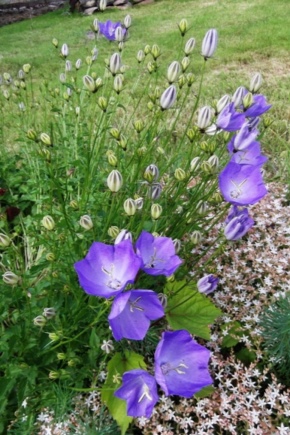
The Carpathian bell is a sweet and touching plant that never goes unnoticed. In growing, a flower can be very demanding and capricious, but the work of a gardener will more than pay off with the beauty of flowering. The summer flower garden begins to play with new colors when it is decorated with Carpathian bells. In this article, we will take a closer look at what these adorable flowers look like and how to properly care for them.
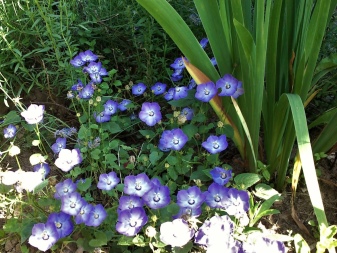
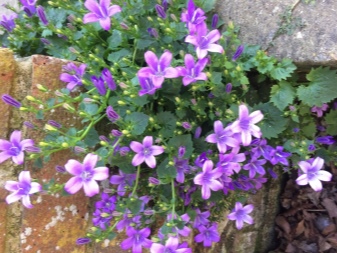
Peculiarities
Carpathian bell or campanula carpathica belongs to the category of perennial plants. This wonderful plant is a lush and sturdy bush, the height of which is usually 20-30 cm. The size of the plant is directly influenced by the condition of the soil, the correct care, the amount of sunlight received. One bell rarely exceeds the 5 cm mark. It has a characteristic funnel-shaped shape.

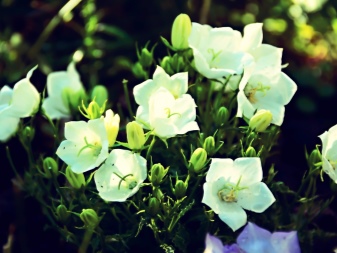
The color of this plant is attractive, delicate and unobtrusive. The colors of the different varieties vary. Manages to meet blue, blue, snow-white and even purple beauties. As you can see from the description, these green pets have calm coloring, so they look great in a company with colorful "neighbors" on the site.
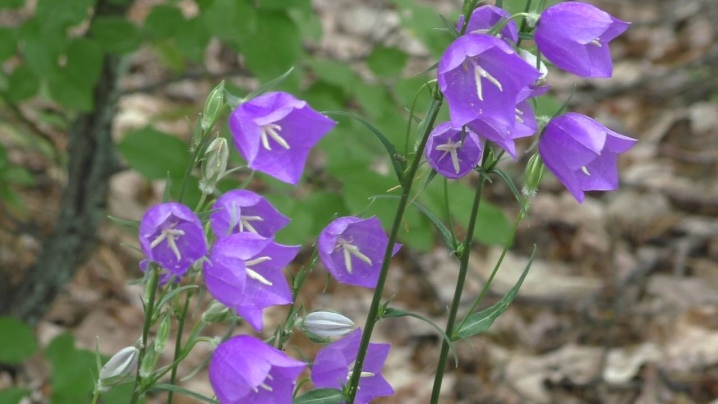
On each base of the plant under consideration, there is only 1 flower. The first blossoming flowers usually appear at the very beginning or in the middle of June. The flowering of the Carpathian bell is long lasting. At the end of this period, a small box with seeds is formed on the basis of the plant. It has the shape of a cylinder.

The Carpathian bell should be planted in sunnier places in the garden or plot. This plant is sun-loving. It is necessary to take into account the level of acidity of the soil. In growing, a flower can be demanding - this must be taken into account by every gardener who decides to plant it.
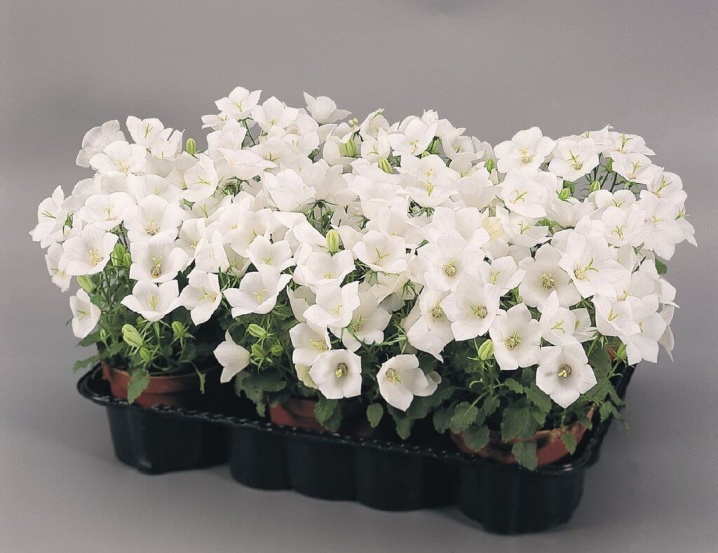
Varieties
The Carpathian bell comes from the class of herbaceous plants. It can be planted in garden beds, in open soil, and in a greenhouse. Many people choose to keep Campanula carpatica at home - this is also possible. Before planting such an interesting plant, you need to correctly select the most suitable variety. If the area for flowers is small, then it is better to give preference to plants that are not too large.
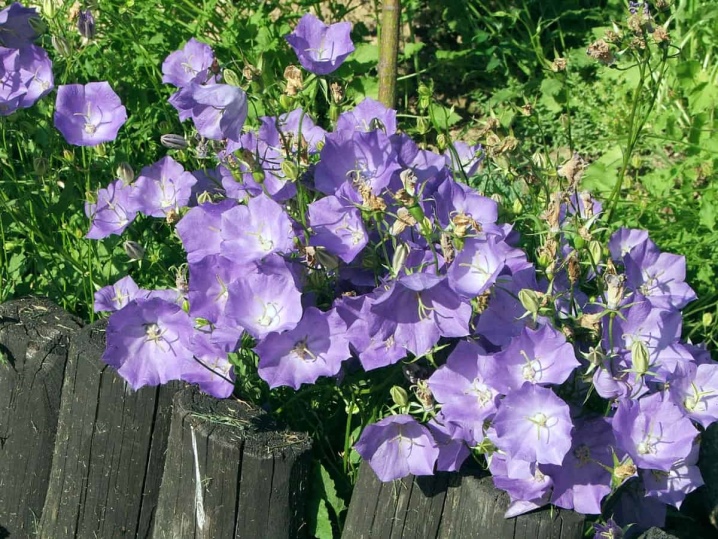
Let's take a closer look at several varieties of the Carpathian bell, which are most often found and are enviable among gardeners.
- "Dwarf". A dwarf bell, which differs in that it bushes in the form of a ball. It blooms in white-blue or snow-white color. The usual height of this bush is 30 cm. "Gnome" grows into a lush and spectacular plant.
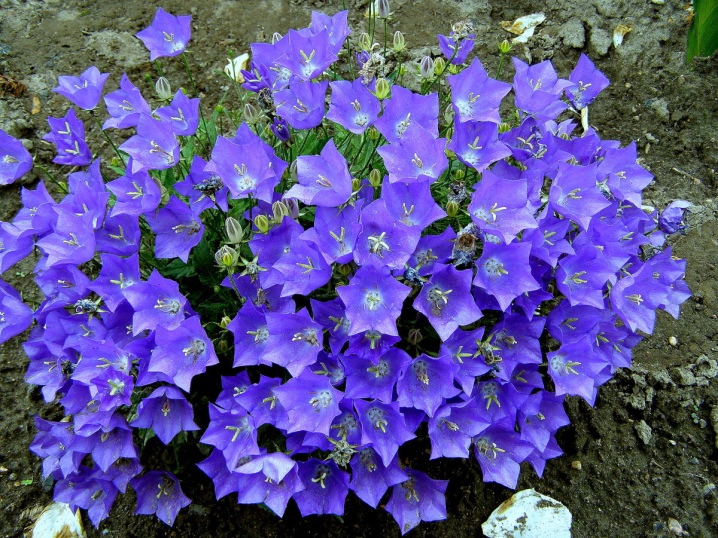
- "Blue clips". The dwarf variety has a height of 20 cm. Peduncles give snow-white or dark blue bells. The plant looks very beautiful, does not need special complex care, which makes it popular among gardeners.
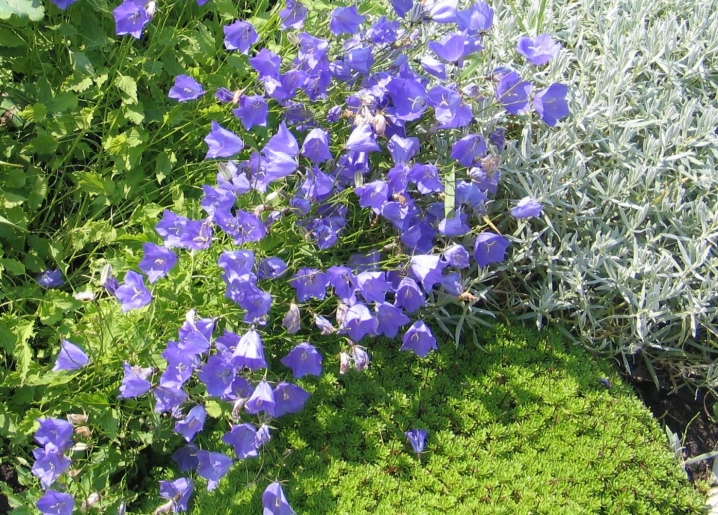
- Alba. Adorable green pet. Flowers of the specified variety in rare cases grow more than 3-4 cm. They are distinguished by an expressive white color.

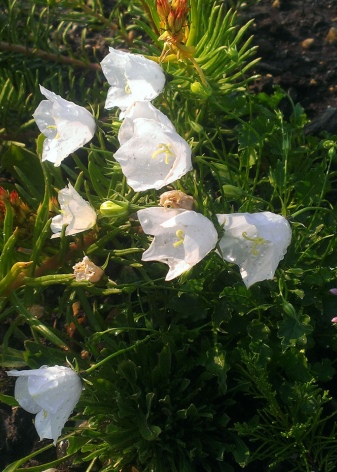
- Celestina. This variety blooms with beautiful bushes with large light blue flowers. The plant attracts a lot of attention in the garden and looks rich.

- Isabelle. The flower can easily become a spectacular decoration of landscape design, since it has rich blue inflorescences. In height "Isabel" usually reaches 30 cm.
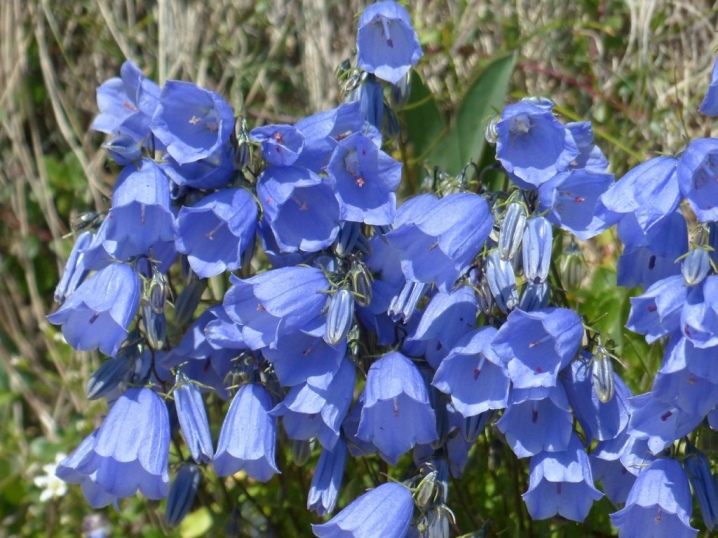
- White is old. One of the most popular varieties. Most often it is chosen for growing in the middle lane. It features a clean, snow-white paint job. Blotches of other colors on the petals are not noticed.
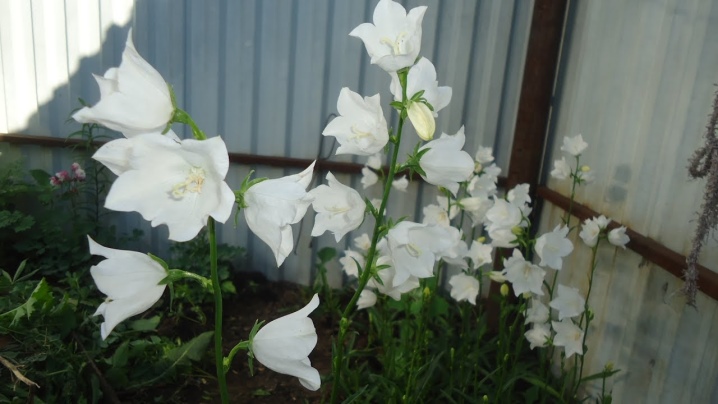
- "Karpatenkrone". The specified variety of bell has appeared relatively recently. Its flowers have a beautiful purple color.
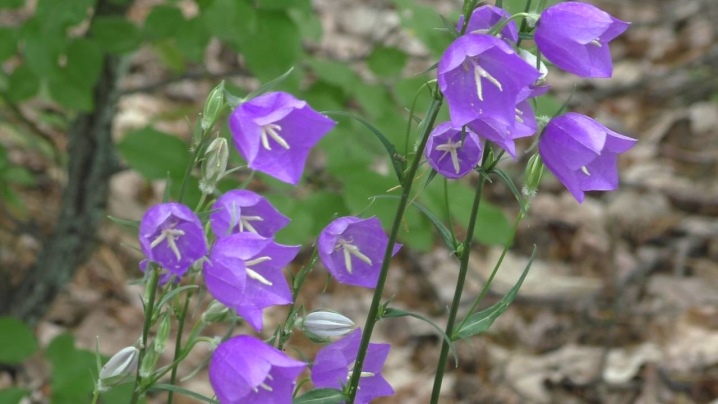
- Pearl Deep Blue. A low-growing variety that belongs to the most long-flowering. Bushes have an almost perfect hemisphere shape.
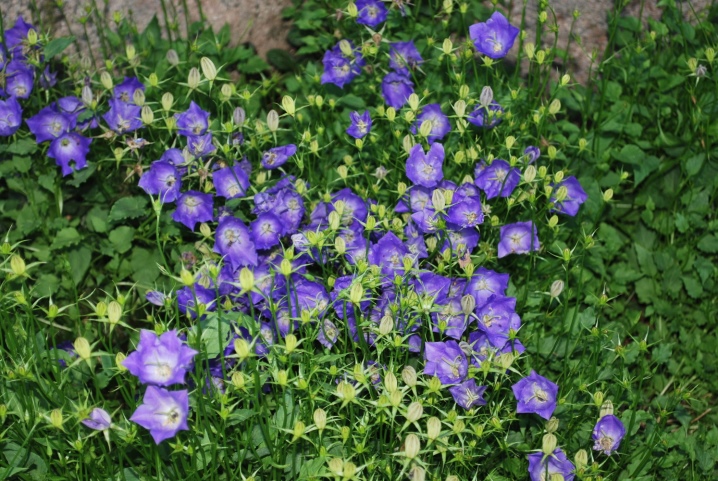
- Pearl White. Spectacular-looking variety, which is distinguished by large snow-white and wide-open flowers. It is characterized by small leaf blades and a height of 25 cm.
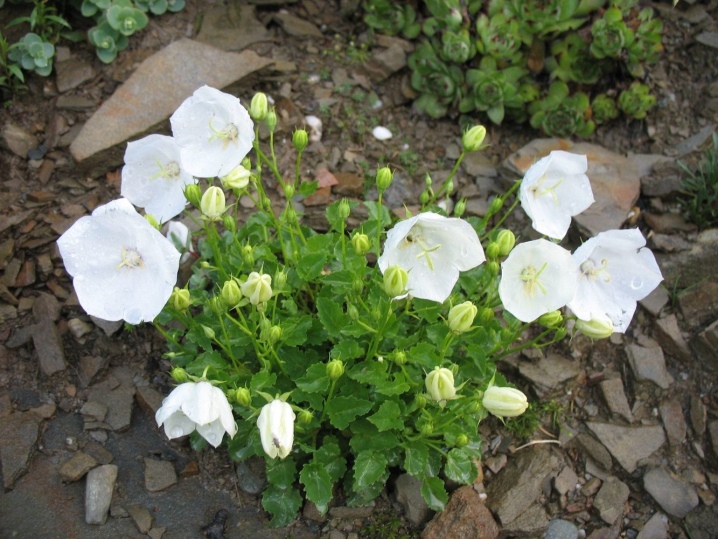
- "Belogorie". Perennial with thin stems. The flowers are funnel-shaped, white. The plant is undemanding to the characteristics of the soil.
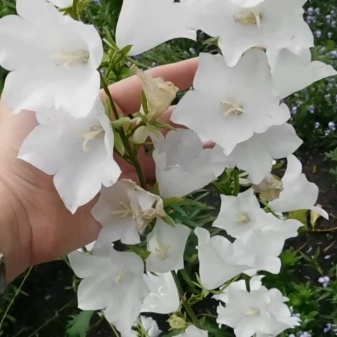

Important! If you want to decorate the site and add various interesting motives to the landscape design, you should choose a mix of the Carpathian bell.

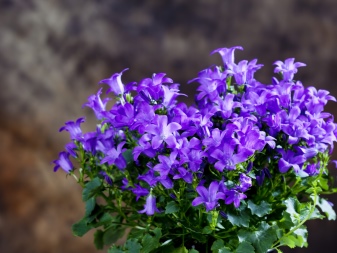
Landing subtleties
It is important to follow all the rules for planting the plant in question in open ground. It should be borne in mind that the Carpathian bell is a fragile and vulnerable culture that is very afraid of drafts. It is necessary to correctly select the best place for a flower. In the same place, the bell will delight the gardener with its flowering for 5 years, provided that the soil layer is correctly selected and prepared.
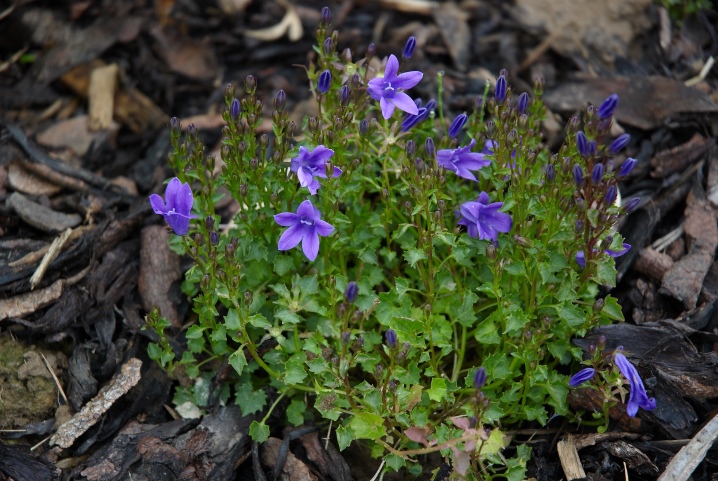
According to the assurances of gardeners, for the described flower, a land rich in nutrients turns out to be a win-win site for planting. It should be loose and with sufficient drainage of fluids. The ground should be either neutral or slightly alkaline. Too acidic or highly alkaline soil mixtures can have a very bad effect on flower rhizomes.
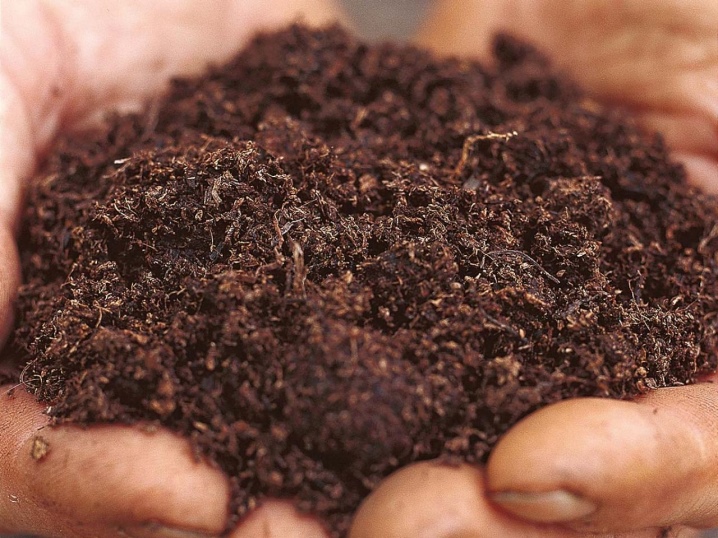
Clay soil is also not suitable for planting - moisture stagnates in it, which ultimately leads to decay of the plant roots. The ideal solution would be a neat flower bed located on a small hill on the site. If the latter has a flat surface, it is worth picking up places with rocky ground. Previously, all the soil will need to be thoroughly dug up. It is better to do this in the spring season. Only after this is it allowed to plant the plant. If there is too heavy soil on the site, then its properties can be improved by combining it with sand of a small fraction, river is ideal.
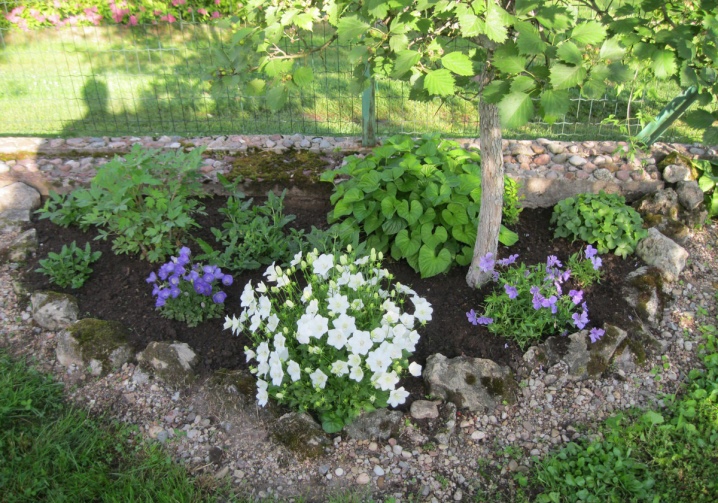
Most growers choose the seed method of planting the bell in question. Seeds can be either purchased or collected independently. The prepared seed must be planted directly into the soil. It is permissible to start these actions only after the soil is well warmed up. The first stems can be expected after 10–20 days.
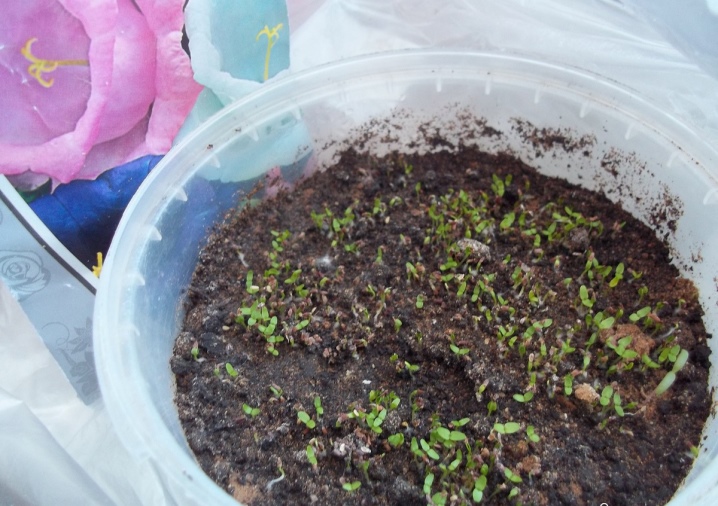
When the first petals "hatch" on young bushes, all shoots must be carefully dived and placed, maintaining a gap of at least 10 cm from neighboring plantings. It is advisable to thoroughly loosen the ground first, since the seeds of the said bell are very small in size. It is allowed to plant seeds in the autumn season, if in May it did not work out for some reason. In cold periods, the optimal time for planting a perennial bell is 2-3 weeks of October. In the case of the described planting, the first growth appears as soon as the snow melts and the ground warms up.
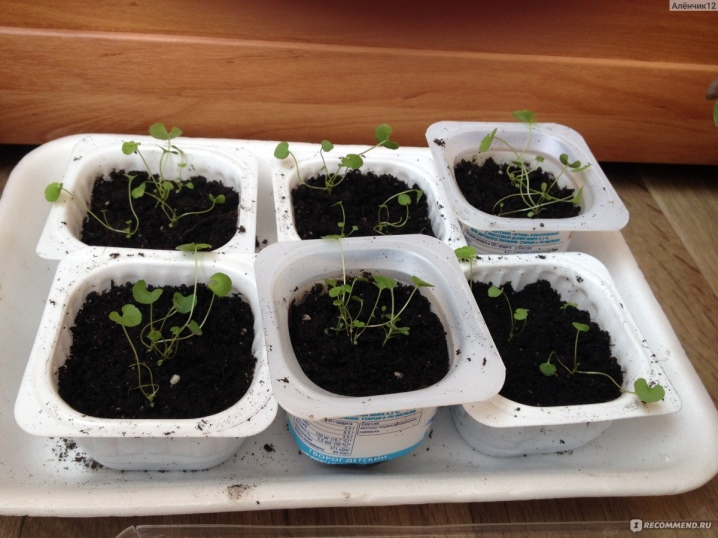
Correct care
It is not enough to plant a Carpathian bell correctly, it still requires appropriate care. Let's take a look at how to water, fertilize and prune this plant.
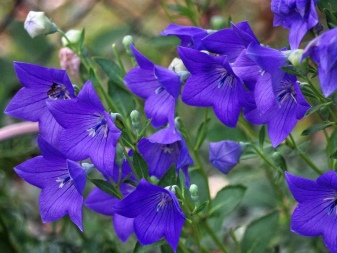
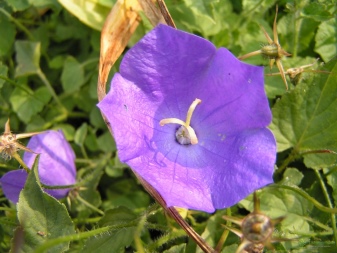
Watering
It is required to provide the pet in question with competent watering. If it rains constantly, there is no need to water the bell. It is necessary to moisten the soil only if the weather is dry. This must be done correctly: at least 10–20 liters of settled water are poured into each square meter. In the remaining time, the rhizomes of the Carpathian bell will easily be able to extract moisture from the ground on their own.
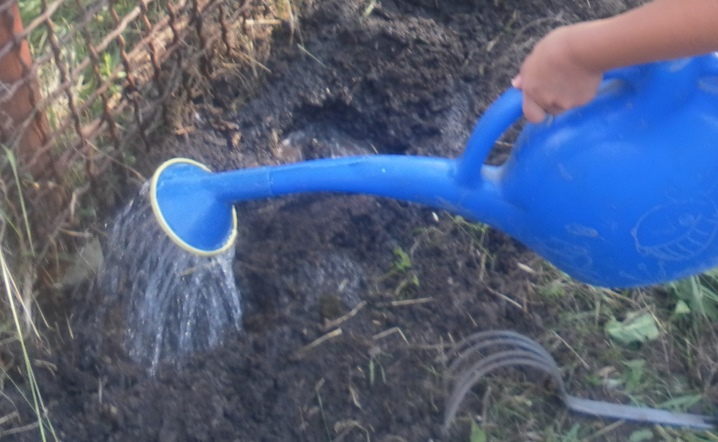
Fertilizer
Perennial bells should be fed twice a year.
- The first time you need to apply nitrogen fertilizers. Ammonium nitrate or urea will do. Powder or granular composition is required to be poured onto the ground 15–20 g per square meter. m. This procedure should be carried out at the very end of March. Organic compounds can be a substitute for mineral dressing. After a snowfall, you can shed a flower bed with a mullein or an infusion of chicken droppings.
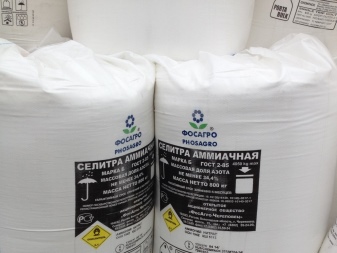
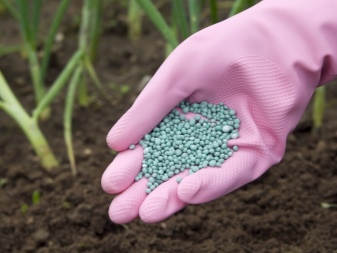
- The second time feeding is required to be added when there is a massive formation of buds. During the flowering stage, bells require potassium especially. It is sufficient in organic fertilizers, which are intended specifically for flowering plants. 15 g of fertilizers are diluted in a bucket of water, then a garden bed with flower plantings is spilled with this composition. Typical consumption is 5 liters per square meter. Ash (500 g per sq. M) can serve as a substitute for such mixtures.
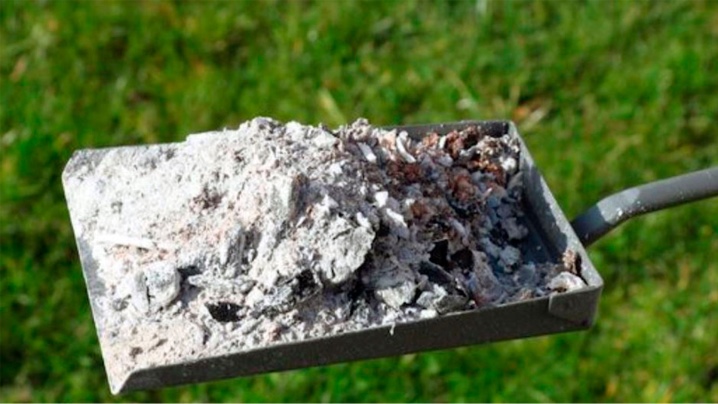
Pruning
The colors in question do not require cropping. However, gardeners can help flowers in the formation of not too narrow, but a voluminous and well-groomed bush, which will be able to release much more buds. For this purpose, it is only required to pinch points on top of the central and lateral shoots of the first order. Such a procedure will stimulate the growth of branches on the sides. But then flowering will be delayed for a couple of weeks.

Wintering
In order for the bell to survive the frosty season without problems, it will be enough to arrange an uncomplicated shelter made in the form of a shaft from a heap of dried leaves. Peat is also suitable. The pile needs to be prepared when constant frosts come. It should be removed with the onset of early spring.

How to grow flowers at home?
Cultivation of the Carpathian bell can be carried out at home. Terry varieties have approximately the same planting and grooming requirements as home bells of an equal-leaved type. For them, you need to find a place sufficiently illuminated by the sun. The light should be diffused. Carpathian bells can only feel comfortable in light shade.
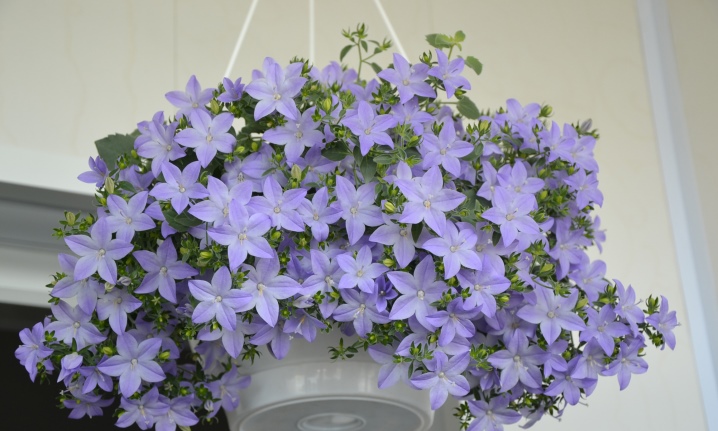
If there is too little light, the shoots of flowers will begin to stretch out (as if in search of the sun), and the flowering will noticeably deteriorate or stop altogether.
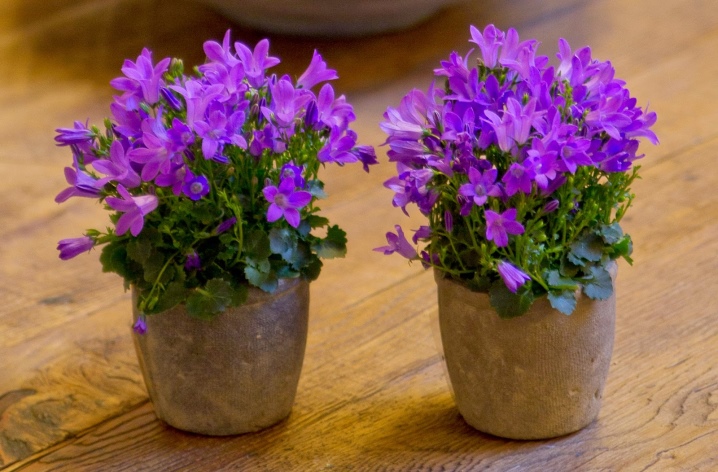
Plants at home must be watered regularly. The moisture content of the soil mixture must always be under control. It is equally important to take care of good drainage. Even if the earthy clod dries up for a short time, this can provoke the buds to dry out. Excess moisture is also dangerous - in many cases it leads to rotting of the plant root system. Carpathian bells do not tolerate dry air well. Because of it, leaf blades can dry out at the edges.
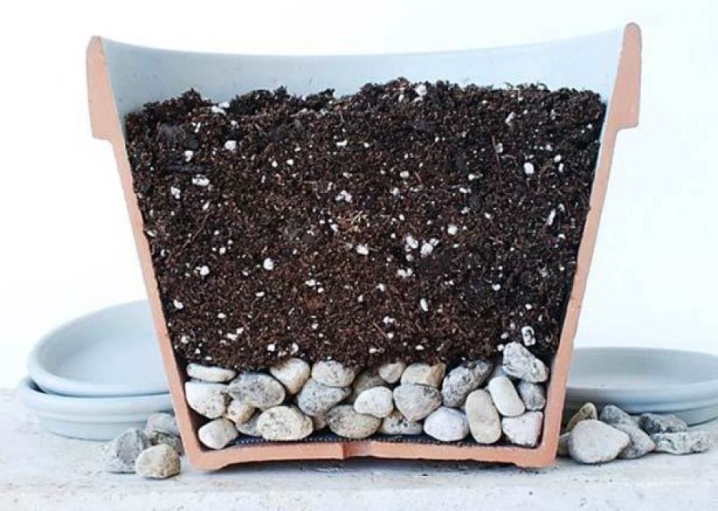
Reproduction methods
In most cases, the Carpathian bell is propagated vegetatively. You can resort to grafting or dividing the bush. Turning to propagation by cuttings, in one season it will be possible to get several dozen different flowers. It is recommended to resort to this procedure in May or early June. The work consists of such stages as:
- all flowers and buds must be removed from the shoots selected for the preparation of cuttings;
- then they are carefully cut with a sharp knife into small pieces of 3-4 cm (at least 1, 2 or 3 buds should remain on each part);
- put them in half, located below, in the solution of "Elin" or "Kornevin" for half an hour;
- while the cuttings are preparing for rooting, combine humus, washed river sand, turf soil (all components should be 1 part each);
- prepare seedling cups or one capacious container, pour earth into it;
- run cuttings into the soil (in a 5x5 cm scheme);
- water the ground well;
- cover the tank or cups with a piece of polyethylene, put it in a sufficiently illuminated place (direct falling ultraviolet radiation should not take place).
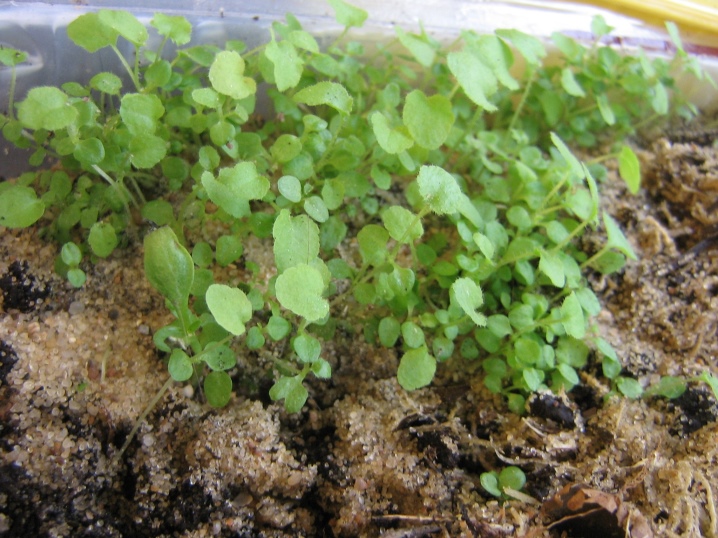
The easiest way is to divide the Carpathian bell. But in this way it will not be possible to get as many seedlings as in the case of cuttings. When dividing, it is necessary to dig up the mother plants. Then they are divided into a certain number of parts. Each part must have roots, stems and leaves. The divided bush is planted in a new, well-prepared place. The best time for this method is May or September.
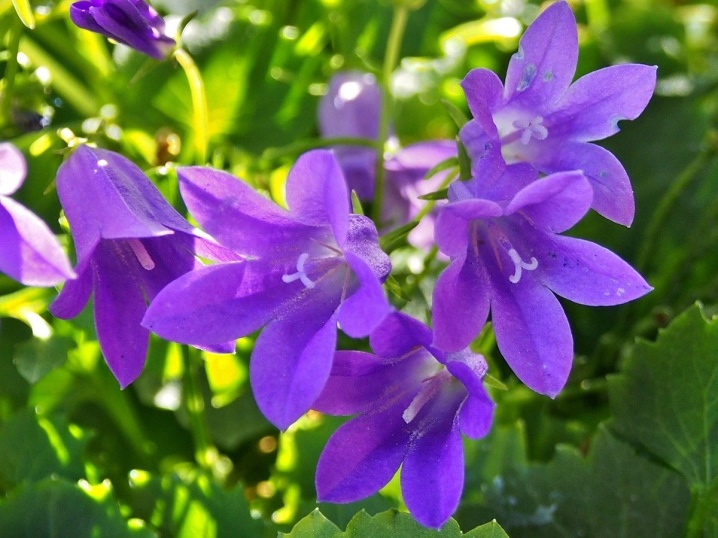
Important! The bell can be propagated by seeds. As mentioned above, they can be assembled by hand or purchased from a specialized garden store.
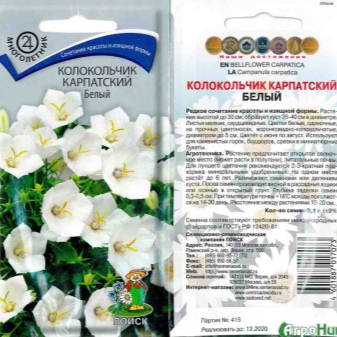
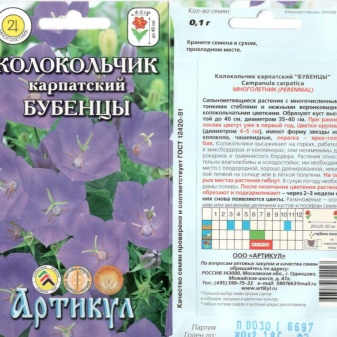
Diseases and pests
Campanula carpathica is considered a plant that boasts a high resistance to many common diseases. Pests of this culture are also not too dangerous. In most situations, gardeners face certain problems when they grow a perennial bush in the same place for more than 5 years. Too long keeping a culture in one allocated place inevitably leads to the accumulation of bad microflora in it. Following this, dangerous pests appear.
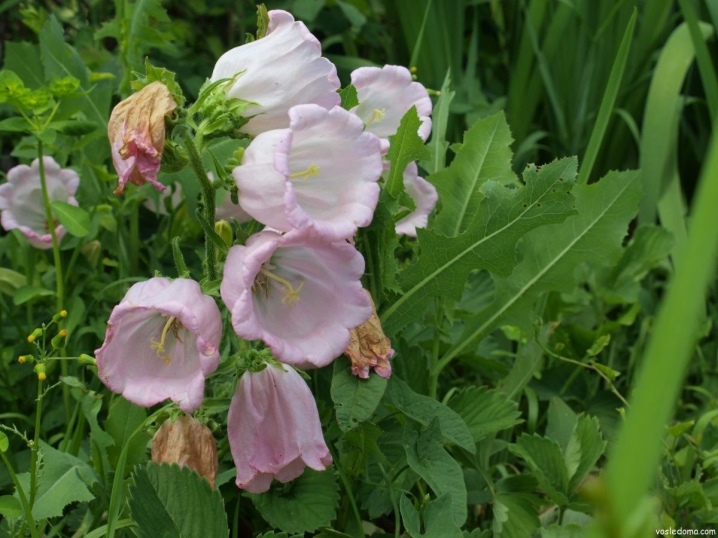
Bells rarely get sick. This mainly happens when the summer is cold or too humid - ideal conditions for fungi. If grayish, brown or rusty spots begin to appear on the surface of the leaf blades or flowers, then the affected parts will need to be removed. Next, the flower bed must be treated with a 0.3% solution of "Fundazol". In order to prevent fungal diseases, the color should be treated with a 0.2% solution of the specified drug before constructing a covering layer for the winter season, as well as after cleaning it.
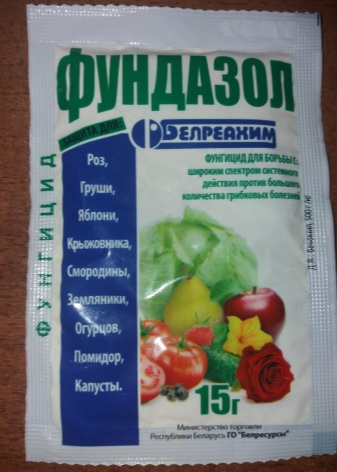
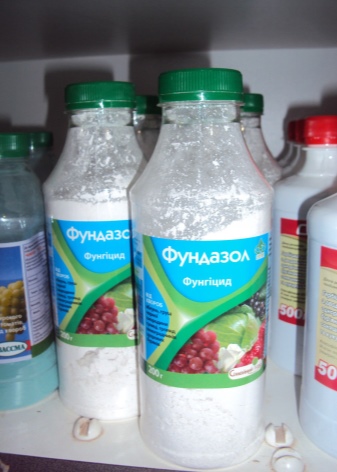
The following pests are dangerous to the perennial bellflower:
- snails;
- slugs;
- slobbering penny.

Gardeners can see these parasites with the naked eye and should be removed manually. You can fight the listed pests in other ways. For example, you can resort to spraying plants with mustard infusion. A tincture of red pepper and garlic is suitable. You can use drugs, for example, "Thunderstorm of the snails", "Thunder", "Meta".

Helpful hints and tips
It is worth planting a Carpathian bell, armed with the following tips from experienced gardeners:
- if you want to provoke a good branching of the plant in different directions, the wilted buds must be removed;
- the best place for planting this flower is an alpine slide;
- when growing bells in potted conditions at home, it is important to ensure that the temperature in the room where they are located does not drop below +20 degrees;
- do not expect a quick flowering of the Carpathian bell if you grow it from seeds; with this method of planting, results can be expected only for 3 years;
- you always need to keep the state of flowers under control - although the Carpathian bell is rarely sick, this can still happen; in this case, it is necessary to take action to treat it as soon as possible;
- the seed material of the bell is recommended to be taken only in proven places and from well-known manufacturers, so as not to subsequently grow a re-grading of the plant;
- you should not fill the Carpathian bell, an excess of liquid will not do it good; excess water can provoke root rot;
- if seeds for seedlings were planted at home, starting in February, then, as a rule, mature seedlings should take place in May; it is important to move it to open ground in time, but do not forget about preliminary hardening of seedlings so that it is ready for outdoor conditions;
- if you notice slugs on the plants, then the best way to get rid of them would be manual cleaning; chemical compositions in this case may not show much effect.
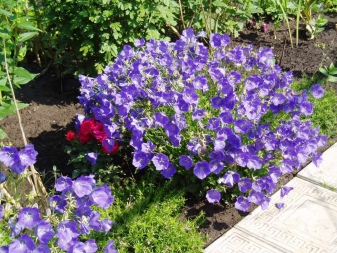
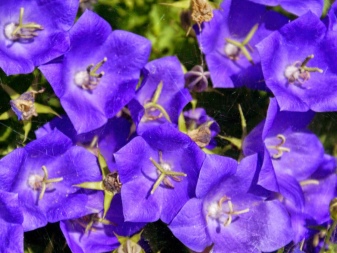
Use in landscape design
The Carpathian bell has a very delicate and beautiful appearance. This plant fits easily into any gardens and surrounding areas. You can decorate the area with this flower in different ways, for example:
- they decorate charming alpine slides;
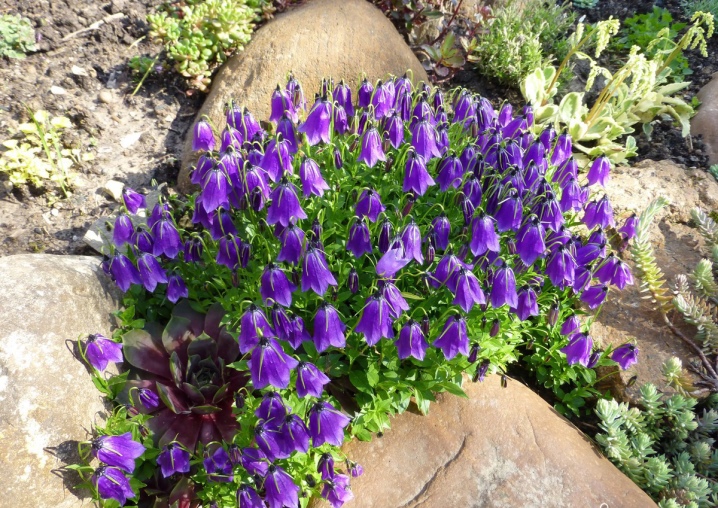
- form spectacular flower borders;
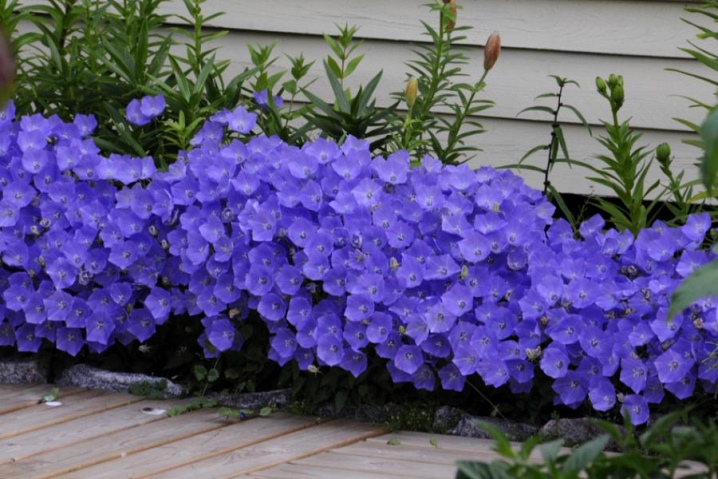
- create very bright and beautiful compositions with other flowers of different colors;
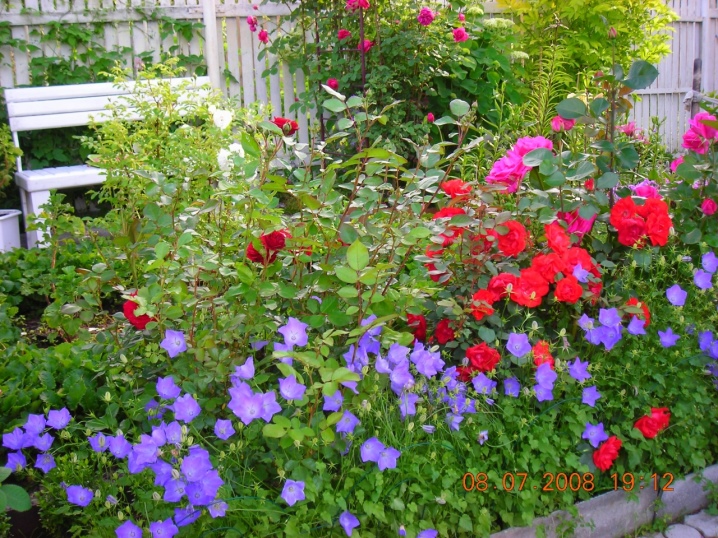
- seated in stylish flowerpots.
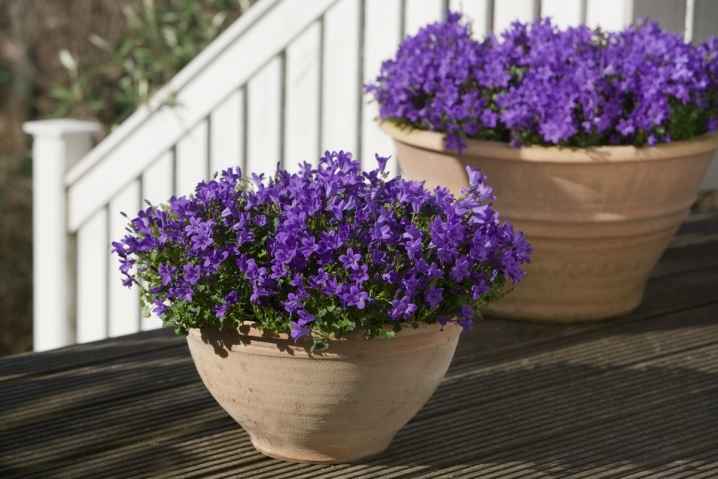
Against the background of rocky expositions, the bell in question looks gorgeous in combination with mountain plants of compact size. The green pet can also be planted along partitions, hedges, paths and paths. To form a rich and variegated flower bed, you can plant several different varieties at once. The most successful neighbors of the Carpathian bells will be the following:
- arnica;
- periwinkle;
- sedum;
- rejuvenated;
- geranium;
- saxifrage;
- lobelia;
- narcissus;
- shaved.
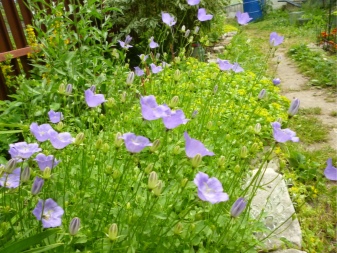
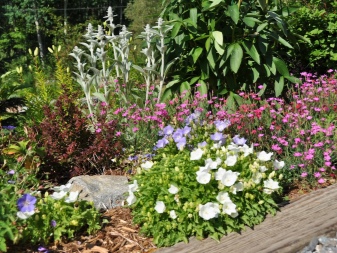
The Carpathian bell can be planted as a solid flowering carpet. In this case, the composition can form some kind of drawing. Such an addition to the site will give it a truly unusual look. To form such a decoration, you need to have certain knowledge and skills.
More details about the Carpathian bell can be found in the video below.







































































































The comment was sent successfully.